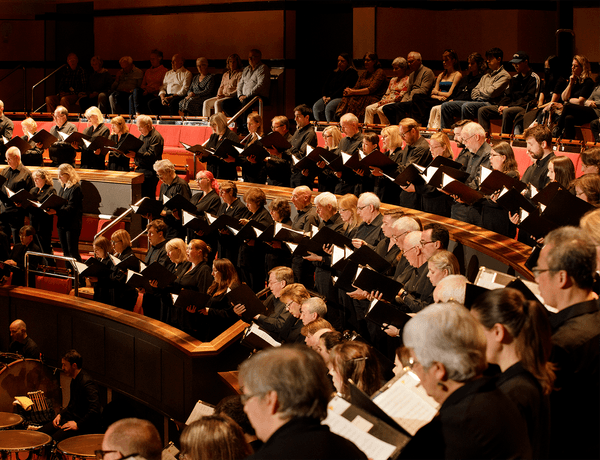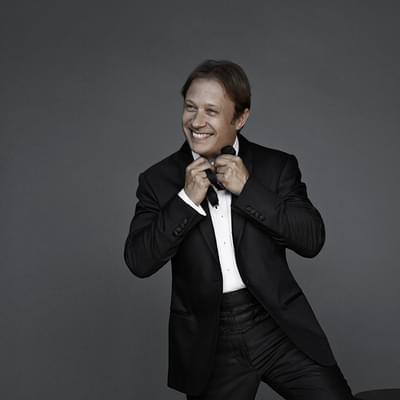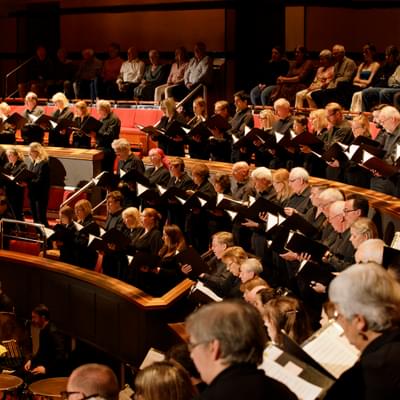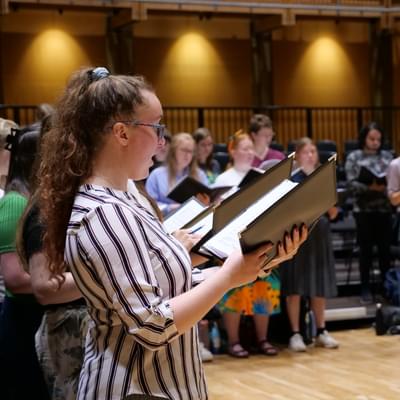Vespers of the Blessed Earth

Full programme
- Adams, Vespers of the Blessed Earth (CBSO Commission: UK premiere) (49mins)
- Sibelius, Symphony No.2 (43mins)
Performers

Ludovic Morlot
Conductor
Katie Trethewey
Soprano
CBSO Chorus
University of Birmingham Voices
Introduction
When asked to conduct John Luther Adams’ Vespers of the Blessed Earth in Birmingham and trying to imagine a good pairing to complement the programme, I could not help but think about the time (just over ten years ago now), that I commissioned John to write a piece for the Seattle Symphony.
I remember very precisely our conversation about the commission which led us quickly to be talking about Sibelius and our common love and admiration for the music of the great Finnish composer.
I quietly suggested to him to write a big symphonic soundscape in the manner of Sibelius' latest symphonies or tone poem Tapiola. The result was his piece Become Ocean which I have had the privilege of premiering and recording with the Seattle Symphony, a piece which won John the Pulitzer Prize and a recording which won us a Grammy Award.
Even though his latest piece Vespers of the Blessed Earth has its own and very singular sound world, I still find that Sibelius would naturally fit as a counterpart and therefore it was a very obvious choice for me to once again programme these two composers side by side.
John’s music is always embracing nature and creates the most beautiful soundtrack for the landscapes around us. Sibelius’ music also naturally is very connected to nature, even in his early symphonic music.
John, again like Sibelius, has this special gift to write music that, through impeccable craft, finds a very organic balance and creates a very fulfilling and moving experience for the listener.
John’s Vespers are no exception and I hope you will surrender to its beauty and enjoy what he describes himself as “an intensely personal expression of grief and faith”, words that could fit any music written by Sibelius also.
Ludovic Morlot
Conductor
Programme Notes
Music born from nature, speaking straight to the heart. “Earth, nothing more. Earth, nothing less. And let that be enough for you…” For some composers, nature isn’t just an inspiration for music. Nature is music. Sibelius imagined his Second Symphony as a great river of melody. And John Luther Adams’s new choral epic Vespers of the Blessed Earth turns images of clouds, canyons and endangered birds into sounds of soul-shaking beauty. Join us, and witness the birth of a masterpiece.
Vespers of the Blessed Earth
John Luther Adams (b.1953)
I. A Brief Descent into Deep Time
II. A Weeping of Doves
III. Night-Shining Clouds
IV. Litanies of the Sixth Extinction
V. Aria of the Ghost Bird
If silence is the canvas upon which musicians paint, few composers can have gone further to obtain it than John Luther Adams.
Having initially found his voice as a rock drummer 1978 he moved to Alaska, and lived and composed for many years in a cabin facing the mountains: a place where, as he put it, “the keynote is silence”.
He’s evolved a compositional voice unlike anything else in contemporary music – elemental, expansive, deeply rooted in his experience of nature and the indigenous cultures of the Far North - and his trilogy of ecologically-inspired orchestral works Become Ocean, Become River and Become Desert (2013-18) has had a worldwide impact. “What I hope”, he says, ”is that the experience of listening to those moments - those long suspended moments in my music - is like sitting in a place and feeling the weather change, feeling the air change, watching the light change”. Adams now divides his time between New York and Mexico.
Symphony No.2
Jean Sibelius (1865-1957)
in D, Op. 43
I. Allegretto
II. Tempo andante ma rubato
III. Vivacissimo
IV. Finale: Allegro moderato
Jean Sibelius conducted this orchestra on 20th February 1921. He stayed with his friend, the composer Granville Bantock, and Bantock’s 14-year old daughter Myrrha remembered the wintry evening when he arrived at Tir-Nan-Og, the family home on Wheeley’s Lane, Edgbaston. “We rose to greet him”, she recalled:
Sibelius was really an ugly man, but he was undeniably striking. The great domed head, which he kept shaved was the first thing one noticed…A thick, short neck and very strange, large ears with long lobes made me think at once of a Nordic troll. I must admit that I found him rather terrifying. He radiated force and power; without knowing why, you felt awed in his presence.
At the concert (at the Theatre Royal, New Street) Sibelius conducted En Saga, Valse Triste, Valse Lyrique (which was encored) and his Third Symphony (dedicated to Bantock). He was warmly received: “I conducted excellently, according to the musicians” he wrote to his wife Aino: praise indeed. The following night, in an expansive mood, he attended a reception at the University of Birmingham. Puffing on a cigar throughout, he gave autographs to anyone who asked.
It had all been a bit less casual back in November 1907, when Sibelius had called on Gustav Mahler at a Helsinki hotel. "We discussed all the great questions of music thoroughly”, Sibelius recalled years later. For Sibelius, what defined a symphony was "its severity of style and the profound logic that creates an inner connection between all the motifs". "No" countered Mahler, "the symphony must be like the world. It must embrace everything". Unsurprisingly, Mahler has tended to be held up as the winner of the exchange, which seems to have been cordial but slightly chilly (Mahler, as a celebrated conductor, assumed that Sibelius was only there to tout his wares, and asked him which of his pieces he wanted him to conduct. Sibelius’s response was stiff with affronted pride: “None”).
But these neat definitions aren't the whole story. Formal logic certainly can't be the only reason why Sibelius's Second Symphony has become one of the best-loved of all twentieth century symphonies. (It was performed three times within a fortnight of its premiere in Helsinki on 8th March 1902, and was sold out on all four occasions). It would have been surprising if Sibelius, of all composers, and in 1901 of all times, could have written a purely abstract symphony. Finland was still a province of the Russian Empire, while Sibelius had been a figurehead of Finnish nationalism for over a decade - so prominently that the Finnish senate had granted him a state pension at the age of 32. He'd had the dubious honour of having one of his works banned by the Russian authorities; his symphonic poem Finland Awakes (1899). It’s now called Finlandia, but until 1917 it could be performed only as Impromptu.
So Sibelius was the hero of a patriotic movement well before he began work on his Second Symphony while on holiday in Italy in the second half of 1901. Music engaged his emotions as well as his mind: the symphony grows with unstoppable power from a quiet pastoral opening to a majestic and unmistakably triumphant conclusion. His compatriots got the message at once. But it wasn't just about Finland.
Sibelius himself was an impulsive, unpredictable man: anything but a granite statue of a National Hero. The Second Symphony is full of personal experience, its first movement aglow with throbbing string chords and dancing woodwinds. A breath of the Mediterranean? Certainly, he admitted that the legend of Don Juan had inspired much of the second movement – the sound of supernatural footsteps echo through the twilit pizzicato that open the movement; cries of terror and glimpses of consolation (he labelled one theme Christus) are boldly and dramatically expressed.
The tension discharges into the vortex of the scherzo, twice broken by a yearning, oboe-led melody: a call-back to the pastoral mood of the first movement before, like Beethoven, it broadens, deepens, and surges forward into the sunlit, striding finale. But the struggle isn’t over yet. Sibelius’s wife Aino said that he first sketched the long, lamenting melody for winds that comes before the final, epic peroration when he heard of the suicide of his beloved sister-in-law Elli Jarnefelt. Sibelius is too honest to give us unshaded triumph.
So there's no shortage of the man and his world in Sibelius' Second. What about that "profound logic"? It's there, and it's brilliant (musicologists have traced it bar by bar); but it's not about musical mathematics - it's in the way that the Symphony grows. From the playful fragments of its opening bars, through the dark passions of the second movement, the whirlwind third, and into the sweeping melodies and victorious trumpets of the finale, it unfolds with the inevitability of some natural force. Sibelius liked to compare the symphony to a great river, into which innumerable tributaries feed before it broadens majestically and flows into the sea. Let the Second Symphony carry you, and see for yourself if this doesn't seem like a wonderfully apt description.
© Richard Bratby
About Vespers of the Blessed Earth
I’ve never followed any particular religion. Music is as close to religion as I get. For me, music is a spiritual discipline, and the daily practice of my art is my form of prayer —a way to transcend myself, to be in touch with mysteries far vaster and deeper than I can fathom.
"I was looking for anyone who could speak the language of the god of no particular religion" Barry Lopez
I’ve never been interested in expressing my personal feelings through music. Yet in 2020 and 21, as wildfires, superstorms, floods, and pandemic, violence and political turmoil raged all over the earth, I found myself composing what may be the most personal music of my life.
Moving into my late sixties, I could no longer ignore my own mortality. My closest friend was in the final months of his life. His decline seemed to parallel the decline of contemporary society, and his death as a refugee from wildfire was an undeniable manifestation of climate change. Amid the night that seemed to be descending all around, I began composing vespers.
Vespers are evening prayers. My distant model was the Vespers of Claudio Monteverdi. But rather than prayers to the blessed virgin, my prayers would be vespers of the blessed earth. I wanted to give full voice to the grief that so many of us feel today, to seek a measure of consolation and solace, and some hope of renewal in the enduring beauty of the earth.
For the first of my vespers, A Brief Descent into Deep Time, I turned to one of the great books of the earth itself —tracing two-billion years of deep time through singing the names, colors, and ages of the geologic layers of the Grand Canyon.
The Kaluli people of Papua New Guinea give voice to their mourning through ritual weeping, derived from birds of the tropical rainforest. The birds weep not only for themselves, but for us as well. In that spirit, I composed A Weeping of Doves, a setting for a capella voices of the calls of the beautiful fruit dove (Ptilinopus pulchellus), native to those same forests.
Sometimes on summer evenings, bright clouds appear on the northern horizon, pulsing with color as if illuminated from within. As we pollute the atmosphere more and more, these noctilucent clouds have become more widespread, as the earth just grows more beautiful. Several of my earlier works are grounded in the harmonic series superimposed on itself, circling upward in a slow spiral. But Night Shining Clouds, is composed on the sub-harmonic series, spiraling downward in a nocturnal chaconne for strings alone.
The heart of my vespers is Litanies of the Sixth Extinction, the text of which is entirely in Latin. Four choirs of singers chant the scientific binomials of 193 critically threatened and endangered species of plants and animals —just a few of the thousands of lifeforms that have disappeared recently or may soon disappear forever— concluding with Homo sapiens.
The fifth and final Vesper —Aria of the Ghost Bird is my setting of the call of the now-extinct Kaua'i 'O'ō (Moho braccatus), transcribed from a recording of the last male of the species, singing for a mate who would never come, singing to the end.
No matter what we humans may vaingloriously believe, ours is not to “save the earth”. With or without us, the earth will endure. The urgent challenge now facing humanity is to save ourselves, to become more fully and deeply human. Perhaps this begins with atonement, that is, at-one-ment —remembering and retaking our rightful place within the larger community of life on earth.
Amid the gathering darkness of our times, we are urgently seeking answers to questions we are just now learning to ask. In my own search, I look to music, art, and poetry, to geology, biology, and ecology, and to my own experience of the miraculous complexity and mystery of this beautiful world, the only home that I will ever know.
The words of the poet Pedro Salinas have become a kind of credo for me:
Earth, nothing more. Earth, nothing less.
And let that be enough for you.
John Luther Adams
Composer, Vespers of the Blessed Earth
Featured image © Andrew Fox
